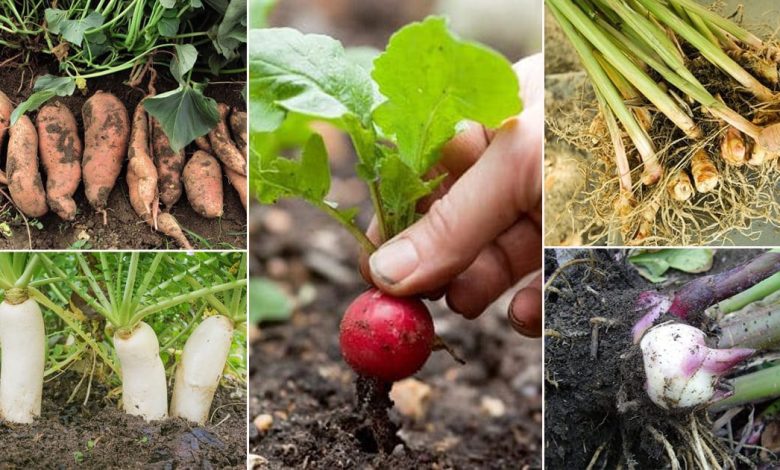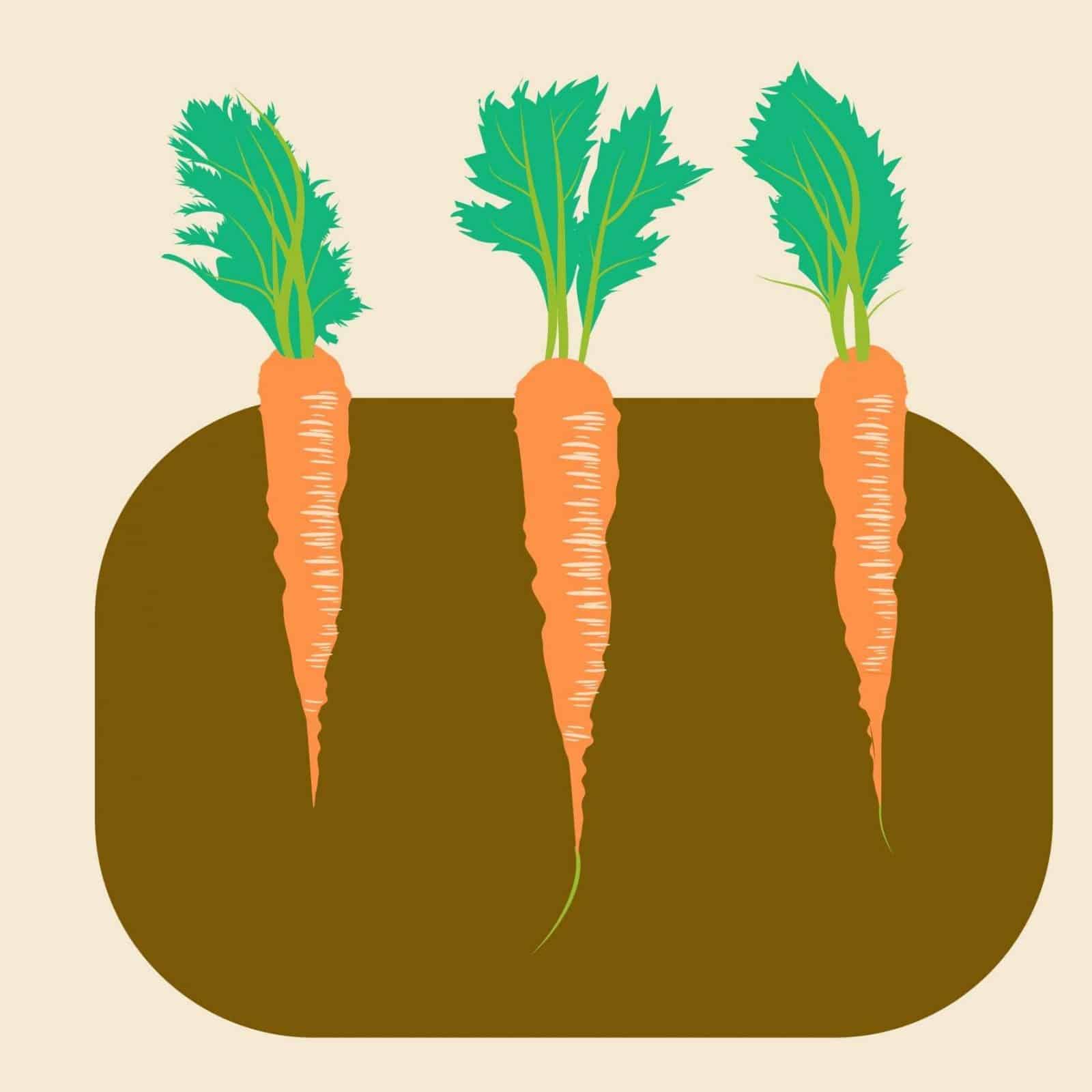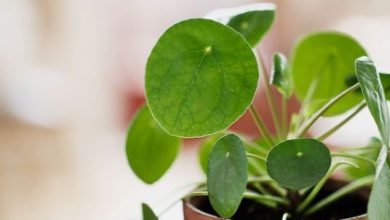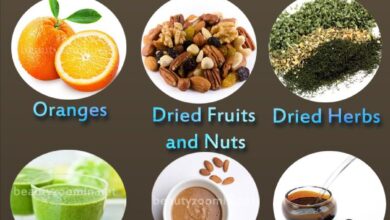Root Vegetables: [Planting, Care and Types]

What are root vegetables?
They are edible root plants.
These are understood as branched and vegetative organs that grow underground, and fulfill the function of absorbing the water and nutrients present in the soil, and then transporting them to the rest of the plant.
It is imperative to note that people often confuse root vegetables with tubers. However, there is a marked difference between the two terms, because the tubers are underground globose stems, not roots.
Plants with edible roots encompass a considerable number of species that do not belong to the same botanical family, due to the fact that they do not have the same external characteristics.
However, within the group of root vegetables, we can find: plants with tuberous roots adapted and thickened to store nutrients produced by external organs; and bulbous plants, whose underground storage organs are produced by the thickening of the base of the leaves (Horticultura.tv, 2011).
Did you know…Did you know that Allium is the genus of onions, garlic, leeks and chives and that its characteristic aroma also serves as a mosquito repellent?
types of root vegetables
Garlic (Allium sativum)
It is not known for sure whether to classify these plants within the Liliaceae family or within the Amaryllidaceae, due to their complex characteristics.
It is a perennial plant with flat leaves up to 30 cm long and a white bulb, which forms a head divided into segments (teeth).
Currently, garlic is used as a powerful natural antibiotic and is an important source of phosphorus, calcium and B vitamins.
To know more: How to plant Garlic.
radish celery (Apium graveolens)
It belongs to the Apiaceae family.
It is cultivated for its thick and spherical root, with dimensions between 10 and 20 cm in diameter. Its leaves are smaller than those of common celery, and equally pinnate.
To know more: How to plant Celery.
Goatbeard or Salsify (Tragopogon porrifolius)
It belongs to the Asteraceae family.
It is a species of annual or biennial herbaceous plant, with an erect stem that can measure up to 1.5 meters in height; basal leaves semi-lanceolate; and robust, long conical and edible root.
Sweet potato (Ipomea batatas)
Also known as sweet potato, sweet potato or sweet potato.
It belongs to the Convolvulaceae family. They are climbing plants; with thin, herbaceous stems; entire or toothed leaves; and thick, edible tuberous roots.
Its nutritional value is higher than that of potatoes and it stands out for its content of pro-vitamin A, vitamin B1 and vitamin E.
To know more: How to plant Sweet Potatoes.
Onion (Allium cepa)
It belongs to the Amaryllidaceae family.
 Biennial herbaceous plant, whose leaves form foliar sheaths that surround a white, yellow or purple bulb (according to the cultivated species).
Biennial herbaceous plant, whose leaves form foliar sheaths that surround a white, yellow or purple bulb (according to the cultivated species).
The onion is used to combat rheumatism, dissolves uric acid and alkalinizes the blood.
To know more: How to plant Onions.
Parsnip (Pastinaca sativa)
It belongs to the Apiaceae family.
It is a biennial species with a fleshy, thick, ivory-colored main root; its short stem gives rise to leaves that form a rosette, and umbels with small flowers.
Although its appearance is similar to that of carrots, in ancient times it served as a substitute for potatoes.
Leeks (Allium ampeloprasum var. porrum)
Also called joint, leek, leek or long onion, it belongs to the Liliaceae family. It is a biennial plant that is cultivated for its edible leaves, bulb and flowers.
A leek can be up to half a meter tall and between 3 and 5 cm thick.
It has a flavor similar to that of onions and is rich in B vitamins; In addition, it is an important source of inulin (a component with different industrial applications).
To know more: How to plant Leeks.
Radishes (Raphanus sativus)
It belongs to the Brassicaceae family. It is an annual plant with an edible root; its stem can reach up to 1 m in height, and have few branches; its leaves are petiolate.
Radishes are rich in potassium.
Beetroot (Beta vulgaris)
Also known as betabel and betarraga, it belongs to the Amaranthaceae family.
It is an annual herbaceous plant, branched and leafy, green or purple. Its leaves are petiolate and its stem can rise up to 2 meters high.
It produces thick, fleshy, edible tuberous roots, red or purple in color (depending on the variety used). It is rich in potassium and is sometimes used as a natural colorant.
To know more: How to plant Beetroot.
Carrot (Daucus carota)
It belongs to the Apiaceae family.
It is a biennial plant with leaves that form a rosette; stem up to 10 cm high; and orange, yellow or purple root (depending on the species) that develops by storing a large amount of sugars.
The roots can be consumed raw, cooked, fried or steamed; they have more carbohydrates than other vegetables and are rich in beta-carotene, pro-vitamin A, vitamin E and minerals such as phosphorus, magnesium, iodine and calcium.
To know more: How to plant Carrots.
Planting of root vegetables
Although root vegetables do not belong to the same botanical family, they have similar needs in terms of planting, watering and maintenance.
In this order of ideas, with the exception of bulbous plants, most reproduce by seeds, so seed beds can be made (with a depth of 2 or 3 cm) for subsequent transplantation to the final land.
On the other hand, both for the bulbous ones and for those transplanted from the seed beds, the plantation must be linear, with spacing between rows of 20 cm for certain varieties of radishes and carrots, 30 cm for beets, 90 cm for sweet potatoes. and so on, depending on root size and species.
The same applies to the space between plants.
Root vegetables prefer light and fertile soils, prepared or fertilized up to a year in advance and free of wet manure, since this can rot the roots.
As for the climate, plants with edible roots require warm or cool climates, being little tolerant to cold.
How are they watered?
The watering of these plants must be regular, so that constant humidity is guaranteed and water stagnations in the soil are avoided.
Whether it is furrow irrigation or a drip irrigation system, the important thing is not to forget that these vegetables are susceptible to both lack and excess water. Regarding the frequency of irrigation, it will depend on the cultivated species.
Sometimes it is recommended to make a mulch to modify the external climatic conditions, guarantee the necessary amount of water in the furrows and protect the crop from the dryness of the soil.
We recommend drip irrigation.
Major pests and diseases of root vegetables
Among the pests and diseases that affect root vegetables we find the following (mainly):
- gray worms (Agrotis): During the night, the caterpillars devour the aerial parts of the plants, and at the end they begin to devour the neck of the edible roots.
- Mildew (Pernospora): It is a disease caused by fungi of the oomycete group. Symptoms appear as yellow-brown spots on the upper surface of the leaves, which suffocate them to dryness.
- Flies: Diptera whose larvae produce galleries in the roots and leaves of the plant. For every variety of root vegetables there is a type of Diptera. The most popular are the carrot mocha (Psila rosae), the beet mocha (Pegomya betae) and the whitefly (Aleyrodidae), which attacks species such as radishes.
- Soil nematodes (Heterodera): It is a pest that parasitizes the roots, causing the leaves to turn yellow and the development of the plant to be paralyzed. There are many species, such as Heterodera carotae, with a special preference for carrots, or Heterodera schachtii, which prefers beets or Swiss chard.
- Aphids (Aphididae): They cause curling of the leaves and weakening of the plants; In addition, they are vectors of viral diseases, especially if they deposit their larvae.
- Rhizoctonia: It is a disease transmitted by fungi to the root of the plant, causing a serious decomposition of the same. The first visible symptoms are yellowing of the foliage and black rotting of the petioles.
History of root vegetables
The birth of vegetables is linked to the first civilizations of the Neolithic period, that is, when man began to work the land for the first time, as a complementary activity to hunting.
From what is documented in the Egyptian tombs and on the gardens of Babylon, it can be thought that most of the vegetables in Europe come from Asia, being introduced by the Arabs during their conquest of the Mediterranean.
 As for root vegetables, there is evidence that the carrot was first cultivated in present-day Afghanistan thousands of years ago.
As for root vegetables, there is evidence that the carrot was first cultivated in present-day Afghanistan thousands of years ago.
At that time, the vegetable was a root that was purple, white or yellow in color and had a bitter taste (Arnetta, 2014).
It was introduced to Europe between the 8th and 10th centuries, and little by little interest in the orange variety was awakened, especially in the Netherlands, since it served as a tribute to the House of Orange in the mid – 17th century.
Parsnips, other edible root plants, were also very popular in the Middle Ages. These roots replaced potatoes in European stews before the encounter with America (Azcoytia, 2008).
On the other hand, we also find controversies regarding the history of these vegetables. For example, sweet potatoes date back at least 10,000 years, and until now were thought to originate in the Americas.
However, different investigations have revealed the possibility that they were introduced to that continent by the Polynesians, which would cast doubt on whether the first ships to arrive on the continent were those of Columbus (BBC Mundo, 2013).

![Photo of Anthurium: [Cultivation, Irrigation, Care, Pests and Diseases]](https://www.complete-gardening.com/wp-content/uploads/2022/08/anthurium-cultivation-irrigation-care-pests-and-diseases-390x220.jpg)

![Photo of How to Plant Passion Flower in Your Garden: [Complete Guide]](https://www.complete-gardening.com/wp-content/uploads/2022/08/how-to-plant-passion-flower-in-your-garden-complete-guide-390x220.jpg)
